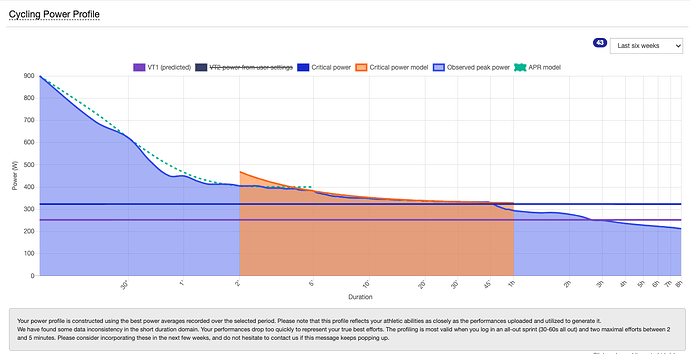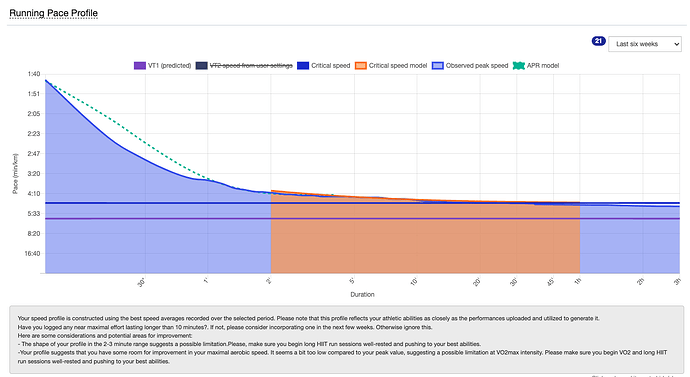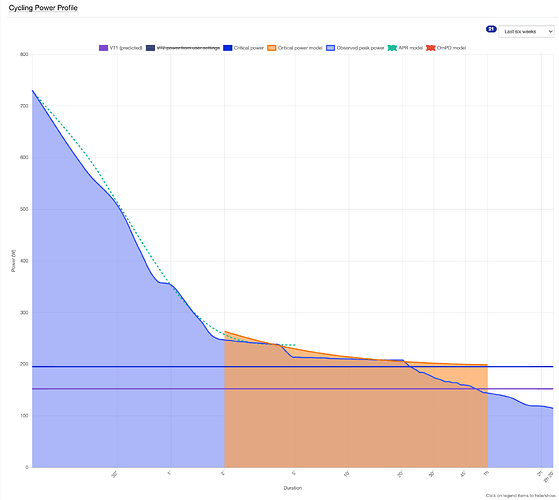Well done to the team on our latest release. Please let us know your thoughts on some of the feedback you’ll be getting about your power and pace profiles. Examples follow.
Love it!! Great work ![]()
![]()
Cool - should we be trying to have our observed peak power/speed match the APR model and the Critical Speed model? What is the difference between the 2 models?
I’ll let the master @Andrea respond to you Cindy when he comes up for air ![]()
@Prof how should we interpret the power profile? I’ll attach mine here. The A/I feedback is, “Your profile suggests that you have some room for improvement in your maximal aerobic power. It seems a bit too low compared to your peak value, suggesting a possible limitation at VO2max intensity. Please make sure you begin VO2 and short HIIT bike sessions well-rested and pushing to your best abilities.”
But, what is maximal aerobic power and peak power, and how do they relate to VO2 Max intervals? I do see that the app has chosen for me to do very tough 30-30 VO2 max workouts, which I’ve been doing for a few weeks.
Another question is, I’ve always been better at time trialing than sprinting. Does this graph tell me that, or does it tell me something else? In summary, I’m having trouble interpreting the graph, even though I read the help page on it.
Thanks.
There are much more knowledgeable on here, but from looking at your graph and reading the suggestion from Athletica it is telling you that your power curve shows a relatively steep drop from 1 second to about 90 seconds, and then it’s pretty flat. The suggestion to include more vo2 work is essentially saying your body currently has the muscular ability to produce powers that your cardiovascular system is currently limiting (I think). So including more vo2 max work in the proper zones 5/low6 then your ability to hold your 90 second power for 105 seconds, then 120 seconds, then longer should improve as your aerobic/cardiovascular capacity improves.
To your second question ![]() , it’s kind of indicating the opposite of your suggestion.
, it’s kind of indicating the opposite of your suggestion.
Not that it matters, but out of curiosity what is your athletic background? If we’re profiling, your graph suggests an athletic history of someone that may have a sporting background of weight lifting or more explosive/short duration sport - which is very normal until years of training have been accumulated.
Again - I may be way off base here, but that’s how I interpret. Also, you have to be your own guide as I assume the AI is generated very much off of averages of the population, which can be misleading sometimes when trying to apply to our own circumstances.
Thanks @Bpellegrin for your response. What I didn’t say but should have is, I think this graph and the corresponding A/I response could benefit by providing more context and explanation.
Your interpretation makes sense to me, and probably that’s why Athletica is giving me VO2 Max intervals every week ![]()
Now for the second question, I was very surprised to see how big the difference is in my sprint power vs steady state time trial power. I raced as a Category IV for seven years, and I did consistently well in time trials but if I was in a road race with a bunch sprint, I could sometimes get top fives but I only ever won a sprint once. I have been lifting weights for 20+ years, so there is that. But I’ve been riding also for 30 years too.
This graph makes me wonder if I would have done better as a Category IV if I had regularly practiced and trained my sprinting skills, which I pretty much never did! That said, the guys I raced against could put out well over 1,000 watts and they could reach speeds close to 40 MPH, which I couldn’t do. Now I compete for age-group Strava segments in local climbs and flat time trial segments.
I had a view at the profiles and descriptions and find the text confusing. The idea of training with Atlethica is that we let AI (and Paul and others on the background) set up the best training. Now in the text under the power profile are suggestions to build a better profile. My understanding is that now I should change some of the plans to match the advice. Do I understand that correctly and should that not be part of the prescribed training?
Thanks for everyone’s input thus far. We wanted to get this out in the live environment for exactly this type of feedback. We clearly have some clarifications to do now and we’ll address this in coming weeks. In the meantime, please continue to throw you two cents in. Thanks all.
I quite like that the comments change based on the period I select.
6 weeks almost exactly matches the period since I was injured. This period is missing specific high intensity efforts, has a few one hour rides, and some 10 hour plus rides. It picks up the lack of shorter HIIT sessions but does not pick up on gap in durations between one hour and ten hours plus. It just suggests it could improve.
3 months the long duration comment goes away.
At this year it picks up on gaps in short duration. It’s correct I haven’t been doing short HIIT as I prefer long HIIT. But for ultra endurance not sure if short HIIT would make a difference over the long HIIT I’ve been doing.
Be nice if I could tag injury and tag when I return to normal training. Then it could tailor comments. I’m unscheduled at moment perhaps it could recognise that and for how long when commenting about best efforts. Plan to return to scheduled plan after recovered from my main event, which starts next week and ends 9 days later.
I love where it is going for sure.
My main feedback are two things. One, please add a line space between the explanation of what the graph is about, and the personalized feedback ![]()
Second, I find it odd, as in the comment above, that the feedback says:
“… please consider incorporating these in the next few weeks.”
when Athletica is an AI powered adaptive platform (i.e. we succumb to our AI overlords choices most times).
Assuming Athletica behind the scenes is taking that data and using it to plan our coming sessions, it should be telling us what Athletica is doing, not what we should do, as we really can’t do much other than follow the plan unless we have a huge library of saved workouts. Something like:
“we will adapt your training in coming weeks to improve this …”
Bonus points if reference is made back to these profiles in the session descriptions themselves so we understand that is what is happening.
Thank you all for your valuable feedback and for chiming in.
@Prof is right, we could not progress in the right direction without the help of you all who decided to take part to the beta program.
@cmaloney, we use two models (APR and CP) to model your power-duration relationship. APR is better suited for short efforts up to 5’, and it can provide us with relevant information about your peak power (very short 1-12-second sprints) and your maximal aerobic power (typically associated with 5’ power). The CP model is better suited for longer durations between 3’ and 1h, and it can provide the boundary between heavy/severe intensity domains (i.e., when you need to gasp for air while speaking). These information can be used to better calibrate exercise intensity in prescription or for comparison with others.
@NorthK this is really interesting to read ![]() . Most likely, you get this comment for the high ratio between your peak power (above 700 W) and your maximal aerobic power (5’ power). Your sprinting potential is suggesting a higher 5’ power potential might be expected, and possibly be the “liming factor” -or the point that deserves attention- right now (?).
. Most likely, you get this comment for the high ratio between your peak power (above 700 W) and your maximal aerobic power (5’ power). Your sprinting potential is suggesting a higher 5’ power potential might be expected, and possibly be the “liming factor” -or the point that deserves attention- right now (?).
As @Bpellegrin is suggesting we are trying to interpret results derived from the average population. At the very moment we cannot suggest (unfortunately) if a cyclist/runner is better suited for a specific kind of race. This will eventually come, I hope. What we are trying to do here is to find out whether the power profile is unbalanced and can be eventually improved. To do so, we check your power profile parameters with what we consider “plausible”.
This bring us to the points raised by @Antonie ![]() At the moment, we do not have the possibility to understand if the profile is “complete” or it is missing some key efforts. In the case of users following the plan to the letter it might be easier to make conclusions, but we also know that, for many, completing high intensity efforts is hard and demanding. If those efforts are not completed, then we might have an incomplete power profile and then misleading conclusions. This is why the “description” is always conservative and we do not act on the training plan right away.
At the moment, we do not have the possibility to understand if the profile is “complete” or it is missing some key efforts. In the case of users following the plan to the letter it might be easier to make conclusions, but we also know that, for many, completing high intensity efforts is hard and demanding. If those efforts are not completed, then we might have an incomplete power profile and then misleading conclusions. This is why the “description” is always conservative and we do not act on the training plan right away.
I hope these comments might help clarifying our intentions, and I hope we can keep on improving this together.




